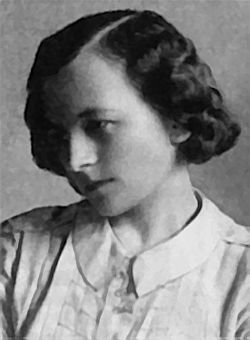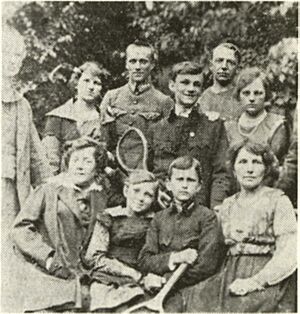Stefania Turkewich facts for kids
Stefania Turkewich-Lukianovych (born April 25, 1898 – died April 8, 1977) was a talented Ukrainian composer, pianist, and music expert. She is known as Ukraine's first ever woman composer. Sadly, her music was not allowed in Ukraine by the Soviet government for a long time.
Contents
Early Life and Music
Stefania was born in Lviv, which was part of Austria-Hungary back then. Her grandfather and father were both priests, who are religious leaders. Her mother, Sofia Kormoshiv, was a wonderful pianist. She even studied with famous teachers and played music with the young opera singer Solomiya Krushelnytska.
Stefania's whole family loved music, and everyone played an instrument! Stefania learned to play the piano, harp, and harmonium (a type of organ). She later remembered how much she loved music as a child:
At the centre of everything was my mother, who played a wonderful piano. As a child, I loved very much to listen to her play. Then, we began a salon orchestra in our home. We played thus: father on the bass …, my mother on the piano, (Льоньо) Lyonyo on cello, me on the harmonium, (Марійка і Зенко) Marika and Zenko … on violins. Father started a family choir as well. These were our first steps into the world of music. Father never skimped on money or made excuses when it came to our musical life.
Her Musical Education
Stefania started her music lessons with Vasyl Barvinsky. From 1914 to 1916, she studied piano in Vienna with Vilém Kurz. After World War I, she continued her studies at the University of Lviv and the Lviv Conservatory.
In 1919, she wrote her first big musical piece, called the Liturgy. It was performed several times at St. George's Cathedral in Lviv.
She continued to study in Vienna, graduating in 1923 with a teaching diploma. In 1925, she married Robert Lisovskyi and moved to Berlin. There, from 1927 to 1930, she studied with famous composers like Arnold Schoenberg and Franz Schreker. Her daughter, Zoya, was born in 1927.
In 1930, Stefania moved to Prague, Czechoslovakia. She studied at Charles University and the Prague Conservatory. She also learned how to compose music with Vítězslav Novák. In 1933, she started teaching piano and became an accompanist at the Prague Conservatory.
In 1934, she earned her doctorate degree in musicology from the Ukrainian Free University in Prague. This was a huge achievement! She became the first woman from Galicia (a region that was then part of Poland) to get a Ph.D. in music.
After her studies, she returned to Lviv. From 1934 until World War II began, she taught music theory and piano at the Lviv Conservatory.
Life During World War II
When the Soviets took over Western Ukraine in 1939, Stefania worked at the Lviv Opera House. She also became a professor at the Lviv Conservatory. When the Germans occupied the area and closed the Conservatory, she kept teaching at a State Musical School.
In 1944, she left Lviv and moved to Vienna to escape the Soviets. In 1946, she moved to southern Austria, and then to Italy. There, she met her second husband, Nartsiz Lukyanovich, who was a doctor.
Life in the United Kingdom
In late 1946, Stefania moved to the United Kingdom. She lived in different cities, including Brighton, London, Barrow Gurney, Belfast, and finally Cambridge, where she passed away.
In the late 1940s, she started composing music again. She also performed as a pianist sometimes, giving concerts for Ukrainian communities in Britain. She was a member of the British Society of Women-Composers and Musicians.
One of her operas, Oksana's Heart, was performed in Winnipeg, Canada, in 1970. Her sister, Irena Turkevycz-Martynec, helped direct the show.
Centennial Concert Hall – Sunday at 7:30 p.m.: Ukrainian Children’s Theatre presents Heart of Oksana, an opera by Stefania Turkevich-Lukianovich, which is the story of a girl meeting mythological figures in an enchanted forest as she searches for her lost brothers.
Her Compositions
Stefania Turkewich-Lukianovych wrote many different kinds of music:
Symphonic Works
- Symphony no. 1 – 1937
- Symphony no. 2(a) – 1952
- Symphony no. 2(b) (2nd version)
- Symphoniette – 1956
- Three Symphonic Sketches – May 3, 1975
- Symphonic Poem «La Vitа»
- Space Symphony – 1972
- Suite for Double String Orchestra
- Fantasy for Double String Orchestra
Ballets
- The Girl with the Withered Hands – Bristol, 1957
- The Necklace
- Spring – (Children's Ballet) 1934-5
- Mavka – ‘The Forest Nymph’ – 1964-7 – Belfast (two versions)
- Scarecrow – 1976
Opera
- Mavka – (unfinished) based on Lesia Ukrainka’s Forest Song
Children’s Operas
- «Tsar Okh» or Heart of Oksana – 1960
- «The Young Devil»
- «A Vegetable Plot» (1969)
Choral Works
- Liturgy 1919
- Psalm to Sheptytsky
- Do Boiu
- Triptych
- Lullaby (A-a, kotyka nema) 1946
Chamber and Instrumental Works
- Sonata for violin and piano 1935
- String quartet 1960 – 1970 (two versions)
- Trio for Violin, Viola and Cello 1960 – 1970
- Piano Quintet 1960 – 1970
- Wind Trio 1972
Piano Works
- Variations on a Ukrainian Theme 1932
- Fantasia: Suite for Piano on Ukrainian Themes 1940
- Impromptu 1962
- Grotesque 1964
- Mountain Suite 1966 – 1968
- Cycle of Pieces for Children 1936 – 1946
- Ukrainian carols and Shchedrivka
- Good Tidings
- Christmas with Harlequin 1971
Miscellaneous
- Heart – Solo voice with orchestra
- Lorelei – Narrator, Harmonium and Piano 1919 – words by Lesia Ukrainka
- May – 1912
- Folk Song Themes
- Independence Square – piano piece
- Lemky song for voice and strings
Her Legacy
Stefania Turkewich's music is considered modern. However, it often reminds listeners of traditional Ukrainian folk songs. She continued to compose music throughout the 1970s. Stefania Turkewich passed away on April 8, 1977, in Cambridge, England. Her work helped pave the way for other women composers in Ukraine and beyond.
Images for kids
See also
 In Spanish: Stefania Turkewich para niños
In Spanish: Stefania Turkewich para niños




